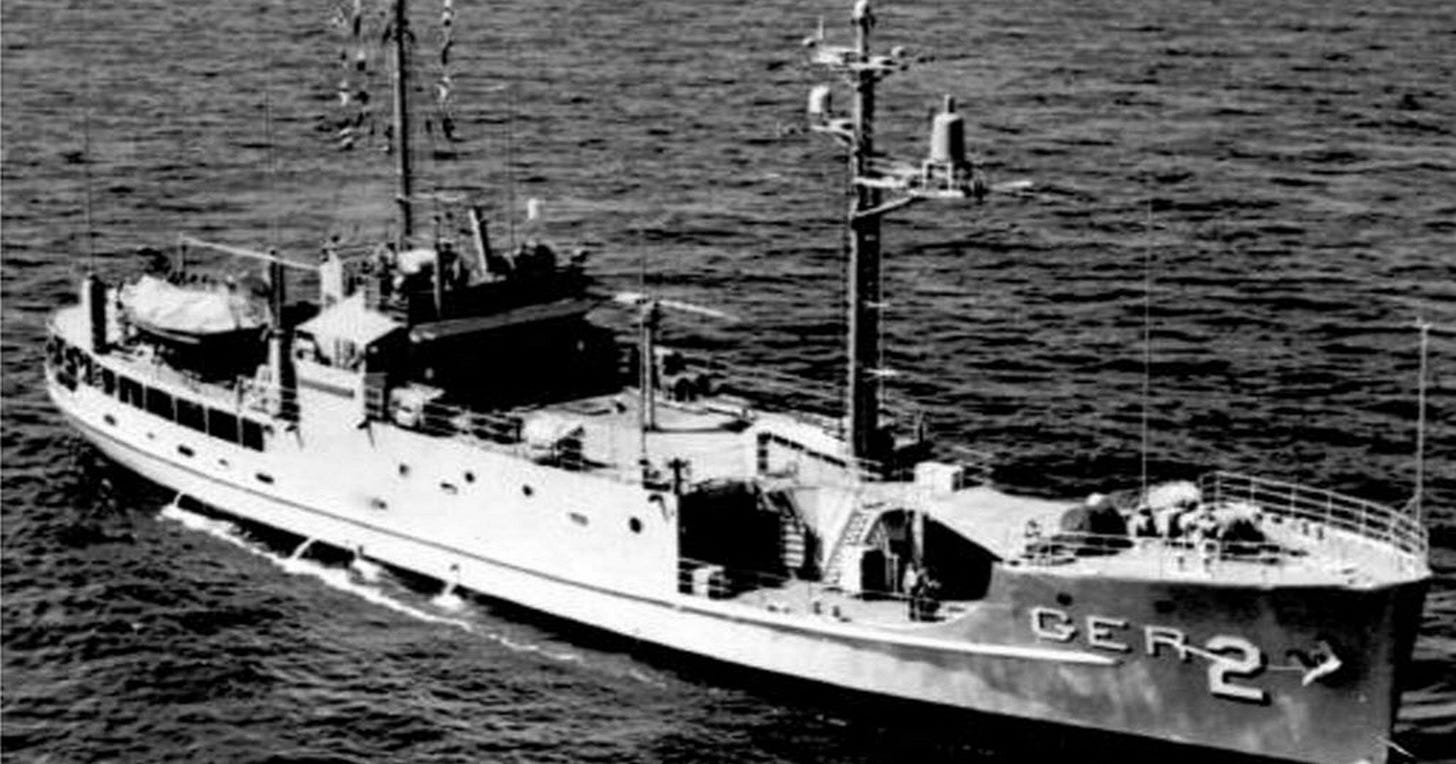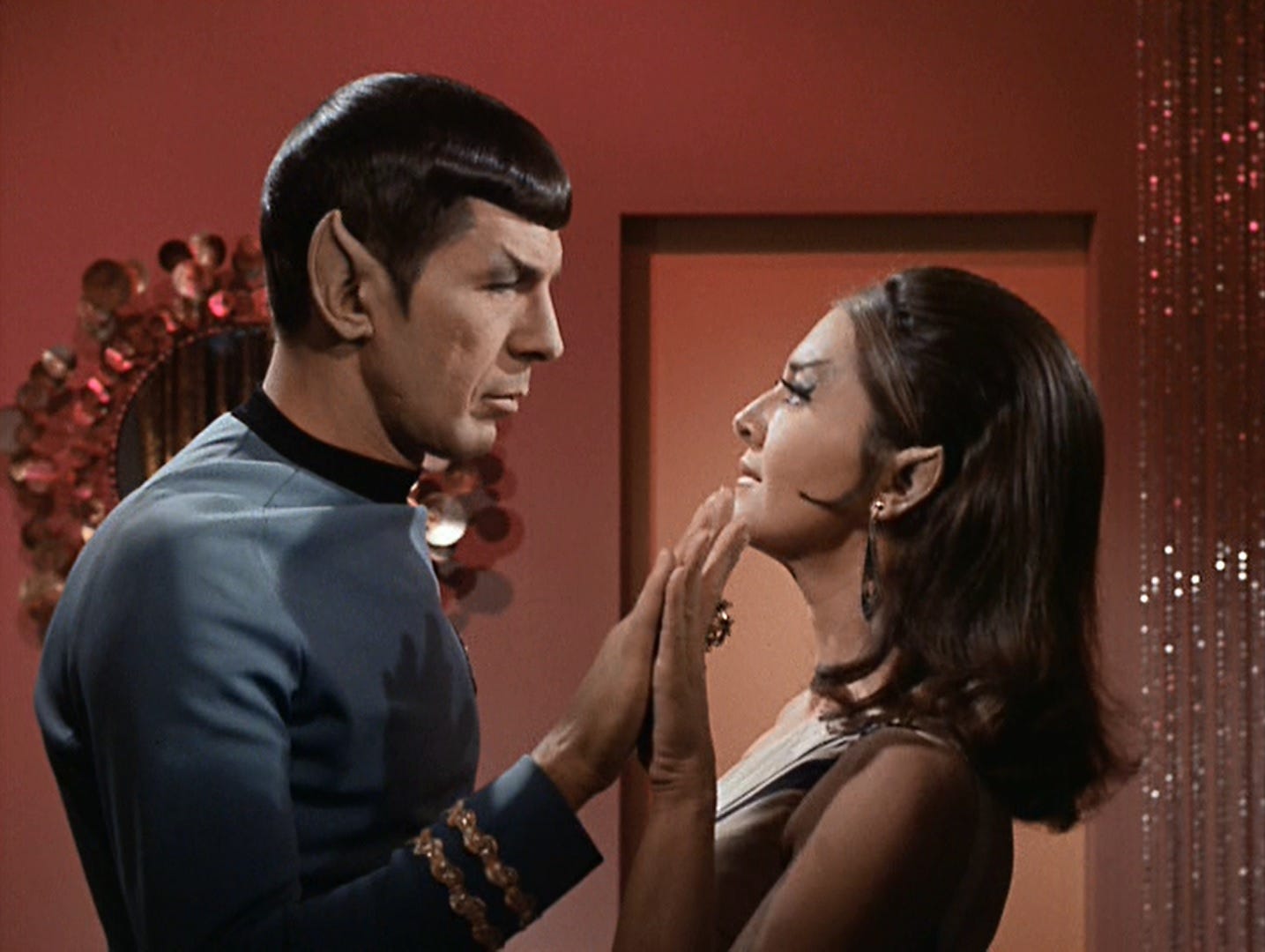"The Enterprise Incident" - Season 3, Episode 2
The Enterprise pulls a heist on Romulus and the audience.
On January 23, 1968, the U.S.S. Pueblo was captured by the North Korean Navy. Pueblo was a small, highly maneuverable ship under orders to gather intelligence related to the Soviet Navy’s presence in the Tsushima Straight and to collect samples of North Korean military communication. Pueblo’s official orders were clear: approach within one nautical mile of North Korean waters, but no further. Her unstated orders are a matter of debate. She flew no flag. Regardless, after a few days of reconnaissance and close calls, the Pueblo was hailed by a North Korean submarine destroyer, which demanded national identification. A cover story involving oceanographic research was quickly blown, and the Pueblo soon found itself surrounded by North Korean Naval vessels with nowhere to go. It remains unclear whether territorial boundaries were actually crossed, but the Pueblo was seized and her entire crew taken prisoner. Negotiations over 1968 eventually secured the release of all hostages (sans one crew member who had died in the initial skirmish) and an admission by the United States of the Pueblo’s official mission. The ship itself remains in North Korean possession, kept as a tourist attraction in Pyongyang.
“The Enterprise Incident” aired on September 27, 1968, as negotiations over the fate of the Pueblo’s crew were ongoing. D.C. Fontana, perhaps the single best writer on The Original Series, based her script on the at-the-time scandalous story, a Cold War conflict all but forgotten and overshadowed by the Tet Offensive. It is a compelling set-up. But what makes “The Enterprise Incident” particularly successful is its clever withholding of information from the audience and its chosen genre of plot progression. While it has a military frame and questions of geopolitical loyalty at its core, “The Enterprise Incident” is a bonafide heist story. It’s Star Trek by way of Ocean’s Eleven. And it is a great time.
Much like Soderbergh’s updated classic, “The Enterprise Incident” understands that while there is appeal in watching a plan come together, it is far more exciting when you do not know all of the plan in advance. Set up and payoff are important, but a rote knocking down of previously flagged problems can be become a mere exercise. What’s entertaining is seeing a crew of people pull of something that feels impossible, with just enough knowledge of their skills and mission to wonder how everything will work out. Thankfully for Fontana, we already know Kirk, Spock, McCoy, and the crew. We know they’re competent, the best in the fleet, and we trust them to make the right calls. Thus, her script is able to play a trick on the audience from the opening moments. Why exactly are Kirk and Spock acting this way?
The Enterprise is quickly surrounded by Romulan ships. Romulan ships had only been previously shown in the absolute classic “Balance of Terror” way back in Season 1. The model for the Romulan “Warbird” had been lost, or possibly destroyed, by production since that episode. Due to budget cuts in Season 3, the model could not be remade, and the Romulans here operate craft identical to Klingon designs in prior episodes. Spock summarily explains this in a single line and the discrepancy is never addressed again.
The episode begins with a medical report from McCoy, complaining of recent irrational and irritated behavior from the Captain. Kirk has been short, tempestuous, and demanding. McCoy is at a loss for an explanation - stress being his only real offering - and the audience is as well. After berating the bridge crew over perceived slights and inefficiencies, Kirk abruptly orders the Enterprise across the Romulan Neutral Zone over their protestations. The ship is quickly flagged and surrounded. A Romulan First Officer appears over the airwaves and demands that the crew stand down or be annihilated, before inviting Kirk and Spock aboard their vessel for negotiations. The two comply.
Once on board, they encounter the true wild card of the episode: a female Romulan Commander, their captor and equal. At this point, the show has never shown such a high-ranking woman character within Starfleet. Her presence is a genuine shock, as is her guile. She quickly identifies with Spock, her “Vulcan cousin,” and demands an explanation of the Enterprise’s flagrant violation of Romulan space from him. Spock complies: the Captain has been acting insane, he is unfit to lead, he must be removed from command. Kirk, betrayed, vows to murder his best friend.
Spock and the Romulan Commander “flirt” as much as they can. The Commander was played by Joanne Linville, a graduate of the Stella Adler Academy who worked mostly as an acting teacher supplemented by consistent television guest spots. One of her most famous students, Mark Ruffalo, once wrote of her: “Joanne does not theorize about great acting. She is great acting.”
It is quite a show, only an obvious farce to an audience familiar with the two’s history. For the Commander, who unfortunately goes unnamed throughout, this is a clear opportunity. The Commander, confidently played by Joanne Linville, has designs of her own. She offers Spock the chance to defect, to return to Romulus with the Enterprise as a check for future glory within the empire and pairs the entreaty with obvious romantic intention. Their flirtation is stoic but compelling; dueling understatement and grand declaration. Despite Spock’s demure tone, he appears immediately receptive.
The Commander could be seen as naive, perhaps, or overly sexualized, but I found Linville’s portrayal clever given the gender dynamics at play. The Commander is, as discussed above, the first female military leader shown across three seasons of the show. It appears unlikely that Romulus is a sexually neutral society; she is by nature an oddity and impressive. Her striving then - these big bets she places on Spock’s loyalty to her, the private softness contrasted with public rigidity, the clear ambition and lack of hesitation - makes sense. If she was not so bold, so risk tolerant, so confident, then she would not be a Commander at all.
Further, Spock and Kirk really sell their roles. Nimoy is reserved, as usual, but with greater obvious pain all over his face. Despite the speed of his defection, it comes across as a struggle, brought on by Kirk’s insanity and betrayal of mission. Shatner, for his part, is good at playing annoyed. To begin the episode, Kirk is dismissive and short above all - any requested explanation is rejected with bluster and a restatement of his authority - which devolves into rage as the situation becomes more dire. Kirk eventually moves to kill the Commander upon trying to escape from the bridge. Spock seemingly kills him with little hesitation.
Spock “kills” Kirk with a “Vulcan Death Grip.” McCoy later clarifies that there is no such thing, but that the Romulans don’t know that. I figured if Vulcans could mind meld and paralyze with a touch, they might be able to kill too, but that is apparently a step too far.
This takes roughly half the episode but is never confusing. Fontana’s script understands that we know something is up and that we trust these characters enough to go along, which is why Kirk’s death is undone in the very next scene. The gig on the audience is finally up. They will accept plenty, but no one thinks the star of the show is going to die mid-episode.
As McCoy and Spock explain to Nurse Chapel - back again, Majel Barrett, with a new wig too! - and Scotty, the object of the mission is to steal a new experimental cloaking device installed onboard the Romulan flagship. Spock’s seduction will hopefully reeal its location, at which point Kirk will beam aboard the ship disguised as a Romulan - with the help of quick cosmetic surgery from McCoy - steal the device and beam the two out. Spock’s romantic entanglement delays him though, and Kirk is forced to beam aboard with little ideal of where the device might be. Delays compound thanks to the Commander’s desperate horniness - it becomes somewhat comical as Spock waits for her to leave him alone - but Kirk eventually discovers the device just as Spock is discovered and captured. The Romulans, able to track the two’s communications, have a new hostage.
Kirk takes command of the Enterprise again after explaining his ruse to the crew, still made up as a Romulan. The “special cosmetic surgery” trick has not been done before on the show but feels like it would have been fairly useful in all those incidents in which Spock had to wear a beanie or hat to hide his ears!
As Kirk installs the device on the Enterprise, Spock is forced to literally filibuster. Summarily sentenced to death, he demands the Right of Statement, a Romulan custom entitling the capital convict to a recorded explanation of their actions. Spock, never particularly loquacious, fights his better nature - while it’s somewhat elided, it seems his statement takes at least twenty minutes - until the Enterprise’s escape plan is ready. They beam Spock aboard - with the Commander accidentally tagging along - click the device on, and escape right out from under the Romulan forces’ noses. The Commander seems bemused, even impressed, by the job they have pulled. She notes that the device is a prototype and any advantage the Federation gains from it will be fleeting. Spock agrees, but hopes they had a connection that was more than fleeting. Ahead, Warp Factor 8, episode over.
I do not see “The Enterprise Incident” as one of the most thematically dense or daring episodes of the show. But it is one its most purely entertaining. No writer on the show better understood the characters she had, and how they were perceived, than D.C. Fontana. Here, she sets them up within a fun, well-paced heist plot full of twists and sexual tension. This is truly Ocean’s in Space and a blast because of it. Thankfully for the crew, things work out much better on the Enterprise than they did on the Pueblo.
Stray Thoughts
At one point early in the episode, Spock assures the Commander that “Vulcans are incapable of lying.” It is of course funny that she trusts this - how can you know if he’s telling the truth?? - but it is also a clever signal to the audience that something is up. We have seen Spock lie numerous times, disguise himself, and outwit with deception. The episode knows exactly how and when to doll out information.








